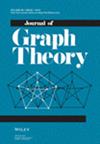d $d$ -connectivity of the random graph with restricted budget
IF 0.9
3区 数学
Q2 MATHEMATICS
引用次数: 0
Abstract
In this short note, we consider a graph process recently introduced by Frieze, Krivelevich and Michaeli. In their model, the edges of the complete graph are ordered uniformly at random and are then revealed consecutively to a player called Builder. At every round, Builder must decide if they accept the edge proposed at this round or not. We prove that, for every , Builder can construct a spanning -connected graph after rounds by accepting edges with probability converging to 1 as . This settles a conjecture of Frieze, Krivelevich and Michaeli.
D $ D $ -有限预算随机图的连通性
在这篇短文中,我们考虑Frieze、Krivelevich和Michaeli最近引入的一个图形过程。在他们的模型中,完整图K n ${K}_{n}$的边是随机排列的,然后连续地显示给一个叫做Builder的玩家。在每一轮,建设者必须决定他们是否接受在这一轮提出的优势。我们证明,对于每一个d≥2 $d\ge 2$,Builder可以在(1 + 0(1)之后构造一个生成d $d$连通图)) n log n / 2 $(1+o(1))n\mathrm{log}\unicode{x0200A}n/2$通过接受1 + 0 (1)) d n / 2$(1+o(1))dn/2$当n→∞时概率收敛到1的边$n\to \infty $。这就解决了弗里兹、克里维列维奇和米切利的一个猜想。
本文章由计算机程序翻译,如有差异,请以英文原文为准。
求助全文
约1分钟内获得全文
求助全文
来源期刊

Journal of Graph Theory
数学-数学
CiteScore
1.60
自引率
22.20%
发文量
130
审稿时长
6-12 weeks
期刊介绍:
The Journal of Graph Theory is devoted to a variety of topics in graph theory, such as structural results about graphs, graph algorithms with theoretical emphasis, and discrete optimization on graphs. The scope of the journal also includes related areas in combinatorics and the interaction of graph theory with other mathematical sciences.
A subscription to the Journal of Graph Theory includes a subscription to the Journal of Combinatorial Designs .
 求助内容:
求助内容: 应助结果提醒方式:
应助结果提醒方式:


